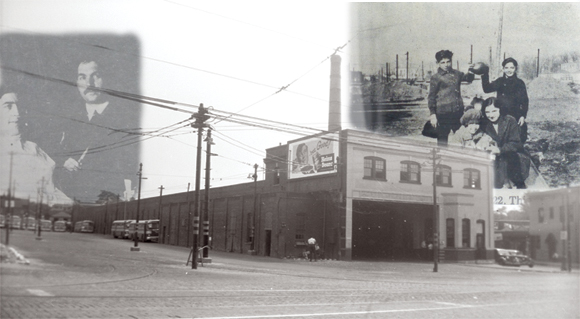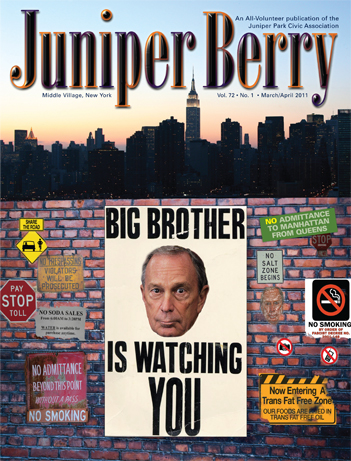For those of us living in Maspeth and towns close-by, it is often very difficult to think of our community as having had a historic past. This is a natural situation where we are faced with the inroads of modern society, both good and bad, which have changed our landscape, our waterways and our buildings. Who can picture Maspeth as it looked to the Indian in the ages before the Dutch came? Who can imagine a raw wilderness village cut by two rutted cart paths as our town appeared in the middle 1600s? Who can see the Dutch and English farmers in 1776, marching off to fight for an independence they barely understood, or the Red Coats marching over the ancient Calamus Road to Newtown? No one.
Because although we love to read about the part our town played in those long ago times there is very little visual evidence left as proof. So we are more comfortable reading about the Gaslight Era; the time many of us can recall, and from which we have many lasting reminders. Even newcomers to our community can walk our streets and see the evidence of the early 1900s. But without a guide something would be lost, and in Mary Micari we have found our guide. But, before we introduce you let’s set the stage.
In the early years after the turn of the century, our town was beautiful in a way that it never can be again. Each morning as you rose to begin another day, the roosters crowed. Not just in your yard, but in every yard along the lane. The smell of bright sun beginning to warm the chilled grass was a natural pleasure as you hurried to wash in cold water, and dress for school.
Out of the house, the air was still crisp and you moved quickly up the dirt road towards Grand Avenue where only a few hours earlier Joe Fetta, the lamplighter, had extinguished the gaslights. Rows of raw looking new brick houses with paved sidewalks lined the cobbled street and trolleys filled with working men in peaked caps and jackets without collars underneath went pushing along to the mills and factories at Flushing Avenue and Ridgewood as well as Brooklyn. Can you smell the clean air? Can you hear the produce peddler calling? Can you see a small boy down at Brown Place, signaling you on to hurry up and wave at the work crew entering the Car Barns? You can? Well then, you are ready to meet our Mary Micari at last.
Mary’s dad, Mike Mungioli, was the barber in the old Car Barns. You can see him in the photo, his shelves are lined with bottles and he has just prepared his customer for a shave. Mike hadn’t been in Maspeth very long, but he has already made a place for himself and his family. He has a good business at the Car Barns and his son has a job as a member of the crew that repairs the trolley cars.
Mike’s family has moved around a bit since they came to town; first, they rented rooms in the house next to the present Times Square Store (now Pioneer Supermarket) on Grand Avenue. Then the family lived for a while on old Perry Avenue, and then Mike heard about some new homes being built on Juniper Avenue (69th Street) a dirt road that ran over in the Lutheran Cemetery at Middle Village. The year was 1923, and all you can see where the present 69th Street runs today, was dirt and the backs of the houses on old Firth Avenue (69th Place). From this new house, Mike had less than a block to walk to his shop in the Car Barns each day.
Mary was one of four children. Her dad, Mike, was the barber in the old Car Barns for 27 years and her brother Bill, was a member of the repair crew which serviced the trolleys.
During their early years in Maspeth, the Mungiolis got to know many of the merchants along the avenue where Mrs. Mungioli shopped. With four children to feed and care for it was sometimes a struggle to make ends meet. But Mary’s mom was a cheerful and resourceful lady who made friends wherever she went. Often she would exchange a piece of beautiful knitted work for an extra treat for her family. Such was the character of our townspeople at that time, that people helped each other whenever they could.)
Mary remembers when John Vogel, (the undertaker now known as Lombard’s) had a shoemaker’s shop on Grand Avenue. This good man knew the children and he fixed their shoes for nothing. In those years, businesses and shops were owned by the old German families. Almost all the grocery stores had German proprietors; like Wiebalk’s Grocery which is now Griff’s Hardware Store and Facklemann’s Grocery where Mary’s Mom exchanged knitting for groceries. Mrs. Facklemann made all her own butter in the old fashioned way, using a churn. In the little barn-like cook shop adjoining the grocery store, she prepared fresh sauerkraut and pickles and all the wonderful foods which now come only in packages.
At the Schublein Bakery, up the block from the present White Eagle Market, Mrs. Mungioli exchanged knitted car hats (berets), for broken cake. And what delicious cake! Schubleins did all their own baking and had their ovens under their shop. Imagine the tantalizing aroma filling your nostrils on a cold winter’s morning?
Mary recalls the Kruch Studio at 65-23 Grand Avenue where the family went to have their photographs taken, dressed in their best clothes and also, the old Firth House, on the corner of Grand Avenue and old Firth Avenue, where the Maspeth Bingo is now. The big white house, with its white picket fence was the home of John Firth and his extensive land also contained the Firth Fife Factory about 1852.
Lamston’s on Grand Avenue today, was the home of the Columbia Movie house, and the old Arion Theater is now Laurel Venetian Blinds on lower Grand Avenue. The Arion was in an old three-story house which was owned by a man named Kunz. And there was an open-air movie on the hill by the Car Barns.
The Aylmer house, which later housed the Aylmer Saloon, was a residence and it was the first home of the Mungioli family in Maspeth. After a busy day, when Mary’s family would just be going to sleep the shoemaker, who had the floor beneath them, would begin to hammer. It seemed unfair that the shoemaker would work quietly all day long and then at bedtime begin to make a racket. So, Mary’s mom decided to stop this noise and she bored a little hole in the floor, directly above the shoemaker’s work area. Then, very quietly, she poured water into the hole so that it went drip, drip, drip, all over the shoemaker and he left his work until the “leak” stopped! This was the way in which the Mungioli family got a proper night’s rest.
Later on, Mary’s family moved to Perry Avenue, the section that is gone now, due to the LI.E. Here they lived in a house owned by a Mr. Gorlick, who owned three houses in all. Behind the Perry Avenue house was a big cornfield in which the children often played hide and seek.
All the children went to P.S. 72 (now Martin Luther High School) on Maspeth Avenue and, walking home after class, they had several places that they liked to stop. One of these places was Devoe’s Blacksmith Shop next to the present Griff’s Hardware. (Mr. Kaiser told us about Devoe’s too!) After watching the horses being shod, the children would hang about in front of Ray’s Hay and Feed Store, next door to Devoe’s. Here they might see the bales of hay being hauled up to the top of the barn on a pulley. (The office building presently on this site is actually the bottom half of Ray’s barn, with the top removed!) The kids also used to stop at Zirkowski’s the Polish blacksmith over on Brown Place where Holzner currently has his ironworks.
Mary’s dad, Mike, was located at the old Car Barns from 1910 till 1937 when he moved to the corner of Caldwell Avenue and 69th Street. In this new location he remained for another 27 years. During his lifetime his family saw the most dramatic changes occur in our town. They saw the Gaslight Era fade and electricity take its place. They saw the horse and wagon replaced by the motorized truck, the first automobiles and the end of the trolley car as a means of transportation. They saw the dirt roads cobbled over, and the cobblers paved over with asphalt.
Transportation improved and land values soared, the open fields, picnic grounds, parks and ponds where the children played were gobbled up by housing and industry. Ashes and garbage were dumped into the beautiful ponds until they disappeared and buildings were placed over them. Land became so expensive that all thought of saving some of it for beauty’s sake was thrown aside. Buildings were crammed into small lots with wall against wall and nowhere was a tree safe from the ax. Progress threatened to destroy a way of life. And then, somehow, a halt was called. No more expansion occurred. The devaluation was over.
In 1954, the old Car Barns symbol of the Gaslight Era was demolished. But many of the other buildings remain with new names, false fronts, and even different roof lines. Look around on your next trip along the Avenue. Don’t drive; walk. And look closely at the shape of the buildings, the slant of their roofs behind the modern fronts. Look up, and look behind the additions and perhaps you will catch a glimpse of old Maspeth in the Gaslight Era.




